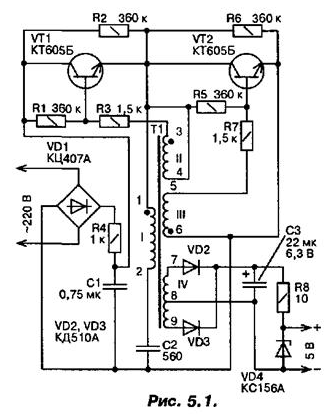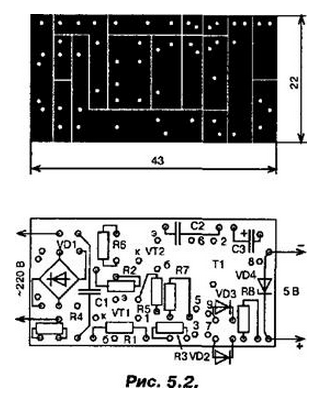The small size of the device is achieved due to the fact that it applied small details. Transistors dissipate little heat: when using them current flows, they are fully open. The source is not critical to the circuit output. The diagram of the power supply depicted in Fig. 5.1. The operating points of transistors VT1, VT2 resistors R1, R3, R5, R7 displayed on the boundary of the cutoff mode. Transistors else closed, but increased conductivity plot of collector-emitter, and even small the increase in voltage on the base will lead to the discovery of transistors: i.e. reduced voltage from the secondary windings of the transformer T1 required for management.
To create conditions for self-refresh, would further increase the conductivity of the transistors, however, to do this by further improving the the voltage on the base, because the conductivity will be different for different transistors and will change as temperature changes. Therefore, the applied resistors R2, R6 connected in parallel to the transistors. When turn on the power source smoothing capacitor C1 is charged through resistor R4 protecting diode bridge VD1 overload. Input the voltage causes the voltage at the output of the launching of the divider, formed by resistors R2 and R6. This voltage is applied to the oscillating the circuit of the primary winding of the transformer T1 and the capacitor C2.
In the secondary winding II induced EMF pulse. The power of this impulse sufficient for introduction of VT1 transistor in saturation, since at the initial time current does not pass through it due to the inductance of the transformer T1. Then starts to receive current from the secondary winding II, holding the transistor VT1 in the open condition. The transistor VT2 during this half cycle of the oscillatory process fully closed. It holds in this state EMF induced in the secondary the winding III.

After charging of the capacitor C2, the current passing through the transistor VT1, ends and it closes. In the second half cycle of the oscillatory process in circuit (T1, C2) current at the initial time, even when the transistors are closed, passes through the second shoulder of the trigger divider (parallel connected resistor R6 and plot the collector-emitter of the transistor VT2). Similarly open the transistor VT2 and then maintained in the fully open condition. After discharge of the capacitor C2, the current through the transistor VT2 he stops and closes. So by the way, the current through the transistors is only in the case where they are fully open and have a minimum resistance of the collector-emitter, so the capacity of the heat loss is small.
The high frequency oscillations straightened diodes VD2, VD3, smooths the ripple capacitor C3. The output voltage is kept constant by the Zener diode VD4. To the output of the power source can be connected load with rated current up to 40 mA. When higher current increase low frequency ripple and output decreases the tension. Slight heating of the transistors independent of the load current, due to the fact that this device may pass through current through the transistors when the first transistor have not yet completely closed, and the second already started to open. The power source can be used until the circuit output current equals 200 mA.
The transformer is made on a circular ferrite magnetic core Chg NN. The windings I, II, III, and IV contain, respectively, 400, 30, 30, 20+20 turns wire PELSHO is 0.07. To increase reliability, it is necessary to isolate one winding from another transformer paper or thin varnished cloth. The magnetic circuit can apply any close initial permeability and size. The Capacitor C2 Is Km-4, or any other of the listed capacity on a nominal voltage of at least 250 V.
In the absence of compact high-voltage capacitors in place of C1 it is permissible to use five of capacitors connected in parallel km-5 group N volume 0.15 μf. Although the references indicate that their nominal voltage 50 In almost most of them can withstand constant input voltage. Their breakdown will not cause any serious consequences, since the resistor R4 works as a preservative. Capacitor C3 - K53-16 or any compact with capacitance and rated voltage not lower than indicated in the diagram. All resistors - S2-23 MLT or other small-sized. Heat sinks for transistors are not required. The working frequency of about 100 kHz when the current consumed by the load, 50 mA. More than the operating frequency of the switching transistors, the lower the inductance can be tuned circuit, and hence smaller the size of the transformer and a power source. Correctly assembled unit power should immediately earn.
However, if the transistors get too hot (which means they are not fully open), choose the resistors R3, R7 and in proportion R1, R5. Output the voltage may be different. To do this, change the number of winding turns and IV replace VD4 another Zener diode. The source can be powered device, performed on digital circuits, and the other insensitive to interference equipment. To power the radios and amplifying equipment it is not suitable because of the relatively large noise level. Noise radiated into the air and brings in network, weak, since the power source is low. The device is the building battery "Krona".
In Fig. 5.2 presents a drawing of the PCB.

The Board is made of one-sided foil fiberglass or Micarta. It can be made without etching, removing the foil cutter on the lines. The transistors should install one slightly above the other, so that their buildings are not touching. The numbers indicate holes corresponding to the pin numbers of the transformer T1. Pins 1 and 4 soldered in one hole. The condenser is located above the diode bridge. Network wire fixed bracket is soldered into the Board. The transformer T1 is slipped onto the pin from wire soldered into the Board, this pin must wear an insulating tube. Output pad soldered short thick wires to the terminals of the Zener diode.
The resistors and diodes are mounted vertically. Assembled unit paper or isolate film from the metal housing battery "Krone" in which and place. When mounting and adjustment of the appliance observe well-known measures precautionary network with a voltage of 220 V.
Author: A. P. Seman






